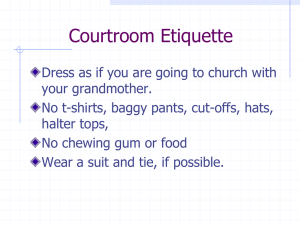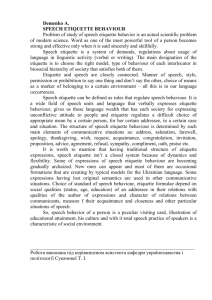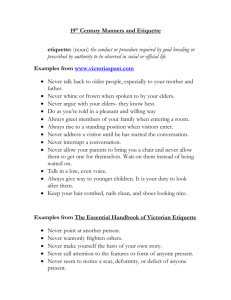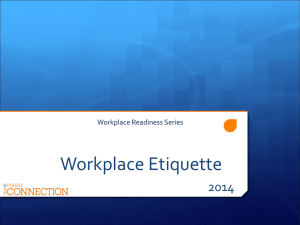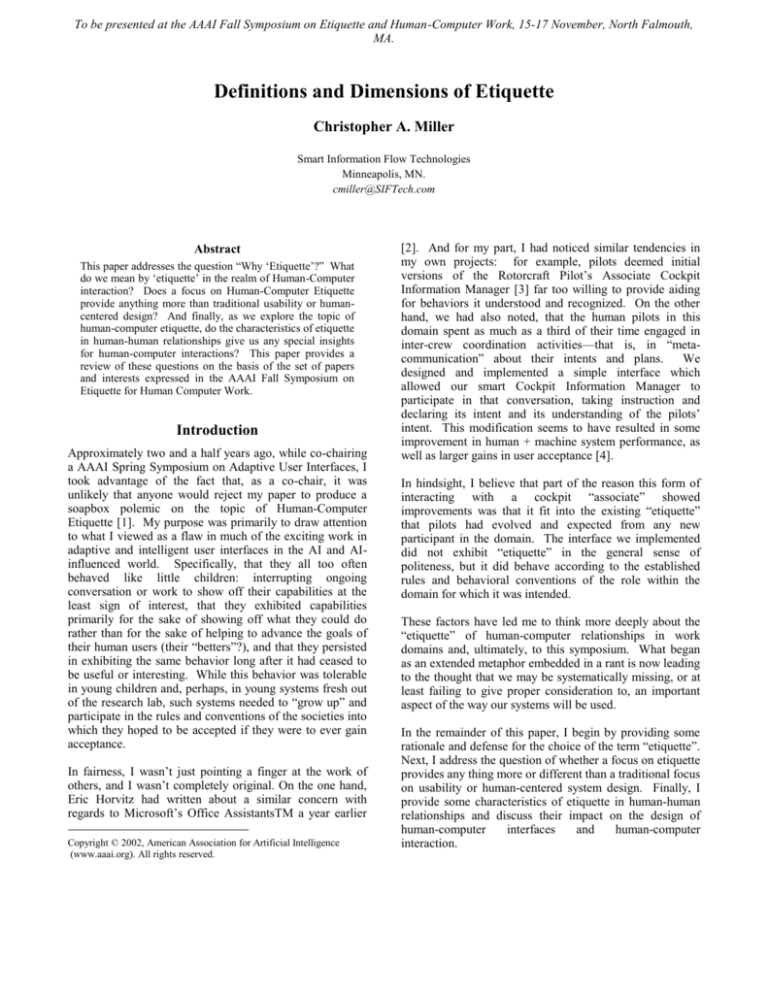
To be presented at the AAAI Fall Symposium on Etiquette and Human-Computer Work, 15-17 November, North Falmouth,
MA.
Definitions and Dimensions of Etiquette
Christopher A. Miller
Smart Information Flow Technologies
Minneapolis, MN.
cmiller@SIFTech.com
Abstract
This paper addresses the question “Why ‘Etiquette’?” What
do we mean by ‘etiquette’ in the realm of Human-Computer
interaction? Does a focus on Human-Computer Etiquette
provide anything more than traditional usability or humancentered design? And finally, as we explore the topic of
human-computer etiquette, do the characteristics of etiquette
in human-human relationships give us any special insights
for human-computer interactions? This paper provides a
review of these questions on the basis of the set of papers
and interests expressed in the AAAI Fall Symposium on
Etiquette for Human Computer Work.
Introduction
Approximately two and a half years ago, while co-chairing
a AAAI Spring Symposium on Adaptive User Interfaces, I
took advantage of the fact that, as a co-chair, it was
unlikely that anyone would reject my paper to produce a
soapbox polemic on the topic of Human-Computer
Etiquette [1]. My purpose was primarily to draw attention
to what I viewed as a flaw in much of the exciting work in
adaptive and intelligent user interfaces in the AI and AIinfluenced world. Specifically, that they all too often
behaved like little children: interrupting ongoing
conversation or work to show off their capabilities at the
least sign of interest, that they exhibited capabilities
primarily for the sake of showing off what they could do
rather than for the sake of helping to advance the goals of
their human users (their “betters”?), and that they persisted
in exhibiting the same behavior long after it had ceased to
be useful or interesting. While this behavior was tolerable
in young children and, perhaps, in young systems fresh out
of the research lab, such systems needed to “grow up” and
participate in the rules and conventions of the societies into
which they hoped to be accepted if they were to ever gain
acceptance.
In fairness, I wasn’t just pointing a finger at the work of
others, and I wasn’t completely original. On the one hand,
Eric Horvitz had written about a similar concern with
regards to Microsoft’s Office AssistantsTM a year earlier
Copyright © 2002, American Association for Artificial Intelligence
(www.aaai.org). All rights reserved.
[2]. And for my part, I had noticed similar tendencies in
my own projects: for example, pilots deemed initial
versions of the Rotorcraft Pilot’s Associate Cockpit
Information Manager [3] far too willing to provide aiding
for behaviors it understood and recognized. On the other
hand, we had also noted, that the human pilots in this
domain spent as much as a third of their time engaged in
inter-crew coordination activities—that is, in “metacommunication” about their intents and plans.
We
designed and implemented a simple interface which
allowed our smart Cockpit Information Manager to
participate in that conversation, taking instruction and
declaring its intent and its understanding of the pilots’
intent. This modification seems to have resulted in some
improvement in human + machine system performance, as
well as larger gains in user acceptance [4].
In hindsight, I believe that part of the reason this form of
interacting with a cockpit “associate” showed
improvements was that it fit into the existing “etiquette”
that pilots had evolved and expected from any new
participant in the domain. The interface we implemented
did not exhibit “etiquette” in the general sense of
politeness, but it did behave according to the established
rules and behavioral conventions of the role within the
domain for which it was intended.
These factors have led me to think more deeply about the
“etiquette” of human-computer relationships in work
domains and, ultimately, to this symposium. What began
as an extended metaphor embedded in a rant is now leading
to the thought that we may be systematically missing, or at
least failing to give proper consideration to, an important
aspect of the way our systems will be used.
In the remainder of this paper, I begin by providing some
rationale and defense for the choice of the term “etiquette”.
Next, I address the question of whether a focus on etiquette
provides any thing more or different than a traditional focus
on usability or human-centered system design. Finally, I
provide some characteristics of etiquette in human-human
relationships and discuss their impact on the design of
human-computer
interfaces
and
human-computer
interaction.
Etiquette for
Domain X
General vs. Specialized Etiquettes
Why use the term “etiquette” as opposed to other, related
terms that denote other, related fields of study (e.g., social
computing [5], embodied or personified agents [6], human
centered computing or design [7], etc.? How does a focus
on etiquette differ from these other fields? As described
above, it was initially suggested to me as a part of an
extended metaphor indicating a direction that sophisticated,
adaptive computer interfaces needed to move in if they
were to perform acceptably for long term use by humans
with jobs to do. It, of course, also has the benefit of being
somewhat provocative—especially among those who are
used to thinking of computers as either unintelligent tools
that must be forced to perform desired tasks, or as demons
actively trying to thwart successful human endeavors.
The term is open to multiple interpretations. The American
Heritage Dictionary defines “etiquette” as follows: “(1) the
body of prescribed social usages. (2) Any special code of
behavior or courtesy: “In the code of military etiquette,
silence and fixity are forms of deference” (Ambrose
Bierce). … Synonyms: etiquette, propriety, decorum,
protocol. These nouns refer to codes governing correct
behavior.” [8]. Of the two definitions offered, the second
is closer to the sense in which I meant, and it led to the
definition included in the Call for Participation in this
workshop:
By ‘etiquette’, we mean the defined roles and
acceptable behaviors and interaction moves of each
participant in a common ‘social’ setting—that is, one
that involves more than one intelligent agent.
Etiquette rules create an informal contract between
participants in a social interaction, allowing
expectations to be formed and used about the behavior
of other parties, and defining what counts as good
behavior.
Etiquette, in this sense, need have little to do with
politeness or the “social niceties,” and specific
environments, specific work “cultures,” even individual
teams of humans will all have their unique sets of expected
behavioral norms or etiquettes. Essentially, an etiquette for
a specific domain is formed by prescribing some subset of
the range of possible human behaviors as appropriate or
inappropriate, expected or unexpected for those who
participate in that domain (see Figure 1). These behaviors
may pertain to speech, dress, movement , etc., or to more
specific protocol behaviors (e.g., ‘in this plant, we always
empty a vessel when it’s not in use’). As such, these are the
behaviors that any human or automation agent should strive
to adhere to if it wants to be accepted into that milieu.
Nevertheless, the first definition applies equally well.
Indeed, several of the papers to be presented at this
symposium [especially 9, 10, 11 and 12] all take the
perspective of etiquette as good manners, though they
Unacceptable
Behaviors for
Domain X
Prescribed Behaviors
for Domain X
Range of Possible Behaviors
Figure 1. Etiquette for a domain defines
acceptable behaviors for that domain.
investigate different aspects of what that might mean and
how it might be applied. This is hardly problematic. Just
as we encounter multiple etiquettes in our daily lives (what
counts as appropriate, expected behavior is different at
work, in a bar, in church, etc.), so computers designed with
etiquette in mind should be expected to exhibit different
kinds of etiquette for the different kinds of contexts they
are used in.
The relationship between the “good manners” and the
“established codes of behavior” meanings of the term
“etiquette” seems to be a simple one of general vs.
specialized application. The etiquette rules of good
manners are general, at least in the sense that they are
intended to apply in situations where no more specific set
of rules is known to apply. For example, the use of
“please” and “thank you” and the polite forms of address
can frequently be dispensed with, but they are a good way
to start an interaction with someone who is unknown to us.
In fact, [13] claims that most of the polite forms in
conversation, regardless of their specific linguistic or
cultural manifestation, are intended precisely to ensure that
the least offensive interpretation possible is applied to our
utterances and actions.
By contrast, the etiquette rules of specialized domains may
be less formal and may involve substantial deviation from
the “polite” forms. Work domains are a common sphere in
which specialized etiquettes prevail—etiquettes that differ
from formal and polite norms. This is true for forms of
address and the use of “please” and “thank you,” but it is
true in more interesting ways as well. For example, (as
Reeves and Nass demonstrate [14]) we take it as
inappropriate for a conversational partner in social
interaction not to maintain a certain amount of small
movements—indicative of a lack of intelligence or
attention, or of artificiality. Nevertheless, an assistant in a
work setting who is always moving about the office may be
seen as intrusive or at least fidgety. It is also true that many
work domains have evolved highly specialized etiquettes
designed to smooth operations and/or ensure safety. The
conversational conventions used between pilots and Air
Traffic Controllers is one particularly formal example,
about which [15] will have more to say at the symposium.
When such conventions exist, whether formally
documented and trained (as in the air traffic control case)
or not, it will be important for computers which wish to
perform actions similar to humans in the domain to perform
in a fashion that preserves the expected etiquette which
those humans would adhere to.
So, in short, both senses of the term “etiquette” seem
relevant for human-computer interaction—though perhaps
in different settings. Politeness and adherence to social
codes will likely be useful in exactly those situations where
it is important in human-human interactions: in general
situations, between strangers, when the specific context or
relationship with the conversant is unknown, when it is
important not to give offense, etc. On the other hand,
especially given that computers are frequently (though
certainly not exclusively) used as tools in the pursuit of
work goals in specific work domains, the specialized codes
of etiquette which are familiar and expected in those
domains will be important for the computer to use.
Workers in an oil refinery are generally not accustomed to
addressing each other with honorifics; therefore it is likely
that a computer system that does so will be seen as out of
place. Pilots acknowledge communications with a “Roger”
and rarely use “thank you”; therefore it will be critical for
an aviation system to acknowledge communications and it
will be unlikely that the use of “Thank you” will be seen as
appropriate.
Is Etiquette ‘just’ good interface design?
The notion of etiquette does, I believe, force us to consider
several aspects of human-computer relationships that
traditional design concerns do not. By placing the system
to be designed in the role of a well-behaved human
collaborator we gain insights into how users might like or
expect a system to act and how its actions might be
interpreted as a social being that rarely come from any
other source of design (with the possible exception of
usability reviews for an already-designed system). I find it
instructive to ask, for example, “if this system were
replaced by an ideal human assistant, how would that
assistant behave?” and, alternatively, “if a human assistant
were
to
provide
this
information/decision
/recommendation/control input in this way, how would s/he
be perceived by colleagues?” To pick, perhaps unfairly, on
a well-known example: how would a human office
assistant who, several times a day, interrupted my work to
offer to help me write a letter be regarded?
Would or should traditional approaches to humancomputer interface design provide similar insights?
Perhaps, but there is a growing set of criticisms claim
otherwise. Traditional approaches to HCI design have
been criticized for being too focused on a single individual
and his or her computer, rather than the role that that
individual (and his/her computer) play in a greater team,
social and/or organizational setting [16]. Similarly, one of
the stated goals of the “social computing” movement is to
design human-computer interactions and computermediated human-human interactions that foster richer
communication and the building of more “social capital”
than have traditionally been the case [5] in existing social
systems such as the internet. Social capital comes, in part,
from interactions that preserve the richer roles and cues of
human-human interaction. Finally, in a recent article and
forthcoming book [17] Don Norman has augmented his
prior calls to usability by claiming that things we regard as
beautiful will be used better—not just because we like them
(though that effect cannot be overestimated), but also
because our liking of them produces cognitive effects
including greater creativity and an ability to be less
distracted by inefficiencies in either the design or the
problem context itself. The relationship between etiquette
and aesthetics is far from clear, but insofar as adherence to
proper etiquette (whether as politeness or the expected
behaviors of the field) produces more “pleasure” than
violations of etiquette, Norman’s claims should hold for
good HCI etiquette as well.
In the end, an etiquette perspective on human-computer
relationships may not so much represent a qualitative
difference over traditional approaches as rather another
perspective that can afford new insights.
After all,
designing a system for “usability” should include designing
for user affect, perceived competence and trust, etc. The
calls cited above for new approaches concentrating on
social or team interactions or on beauty and pleasing
aesthetics are de facto evidence that traditional approaches
have not been completely successful in providing those
foci. In the next section, I will describe some insights to be
derived from concentrating on the etiquette of relationships
(human-human or human-computer). These serve as
additional evidence that an etiquette perspective can
provide valuable novel insights into the design of computer
systems for human work.
Characteristics of Etiquette
The notion of etiquette conveys several profitable
characteristics profitable for reasoning about humancomputer relationships and that, ultimately, may prove
useful in designing better human-computer interactions.
Below is a list of some of the characteristics of “etiquette”
and some lessons that they teach us for interface design:
Different Etiquettes for Different Interactions.
One such characteristic is illustrated in the discussion in the
first section above: different contexts, and different types
of interactions have different etiquettes associated with
them. We have different rules of expected conduct for
formal and informal situations; for work, party, home and
church. The appropriate etiquette is, therefore, a function
of the set of contexts in which we find ourselves (see
Figure 2). Talking about a football game with a work
buddy at church would involve a different set of
conventions and behaviors than talking about church to a
football player we’d just met on a tour of our work
environment. As social beings with years of experience,
we navigate these extraordinarily complex waters almost
effortlessly, but computer systems must be taught them.
Etiquette evolves.
An implication of the role of inter-agent familiarity in
etiquette is that etiquette evolves over time. As noted
above (and in [13]) initial forms of etiquette tend toward
the more formal and polite precisely because these are the
most general ways of showing respect and benign intent in
most societies. As we become more familiar with a person,
or a context, etiquette relaxes, becomes less formal, and
typically more efficient. The implication for humancomputer etiquette is that some form of learning or tuning
may be very useful or necessary.
Etiquette is mostly implicit.
As noted above, the appropriate etiquette for a given
specific context is a function of the set of expected
behaviors for the overlapping set of contributing contexts.
Not only is this reasoning process likely to be very
complex, but it is also largely implicit. The reason that
Miss Manners and her fellow etiquette mavens flourish is
that we are uncertain about what etiquette should be used in
various settings. Worse, the introduction of a computer
will, necessarily, change existing etiquettes and new
Figure 2. The appropriate etiquette in a context is a
function of etiquettes for the set of overlapping
contexts in which we find ourselves.
etiquettes will evolve—as they have done for email and
voice mail [18]. On the other hand, this may be a saving
grace for novel technologies—they have some ability to
establish their own etiquettes when no prior etiquette (or
only conflicting etiquettes) exist.
Etiquette is (only) expected of “intelligent” agents.
Another implication of using etiquette to reason about
human interactions is that we don’t expect etiquette of
inanimate, unintelligent entities.
Simple tools like
hammers and wrenches (or even sticks and rudders) don’t
foster, or perhaps need to foster, expectations about
appropriate interaction behavior on a social level. It is only
as those tools take on more complexity, higher degrees of
autonomy and more ‘intelligence’ that we start to expect
them to play by the rules of other complex, autonomous
and intelligent entities in our experience—namely, other
people. Reeves and Nass [14] both show that our
willingness to assume intelligence and agency extends far
deeper (and requires fewer triggering cues) than we
commonly expected, and offer as partial explanation the
notion that we are applying schemas learned for
interpreting and interacting with humans to other agents
that behave, in some minimal ways, like humans. The
implications for design are that, as systems become more
complex, adaptive, autonomous, etc., the importance for
them to exhibit appropriate etiquette increases—and
conversely, the sensitivity of users to inappropriate
etiquette will increase.
Etiquette implies a Role.
It is rarely sufficient to simply attempt to adhere to the
etiquette of a domain. Rather, domain etiquettes typically
define and prescribe behaviors for various roles within the
domain. This is true of both the general etiquette of
politeness, where roles such as petitioner/requester and
responder/provider are highly embedded in polite
behaviors, as well as the specific etiquettes of work
domains, where the prescribed behaviors differ if one
occupies the role of, say, pilot vs. co-pilot. In both cases,
the set of prescribed behaviors pertain to a specific role for
that domain and if I am attempting to occupy one role
while making use of the behaviors reserved for another, I
am likely to create even more confusion (and resentment)
than if I avoided the use of the domain’s etiquette
altogether. Imagine, for example, the servant who holds his
hand out to be kissed by the king. As Figure 3 illustrates,
the acceptable behaviors prescribed by an etiquette for a
domain may not be acceptable for all participants (i.e., all
roles) in that domain. In fact, what is acceptable and
expected for one role may be strongly forbidden for
another role. Power relationships are a frequent, and
highly important, form of role definition within etiquettes
and one which computers and automation can easily
transgress in work domains.
and/or efficient interactions but, when sufficiently
motivated, we can readily “dispense with protocol” and get
down to business. This implies that while adherence to
etiquette can make interactions smoother, more pleasant
and maybe more efficient, considerations of etiquette will
rarely make or break a system design in their own right. In
this sense, etiquette generally poses “soft” constraints, by
contrast to the “hard” constraints that physics and human
physiology impose.
Figure 3. Role relationships with an etiquette for a
domain.
Etiquette is Functional, yet Arbitrary.
Another characteristic of etiquette in human-human
relations is that it is functional, and that the functions are
largely homogenous across societies and cultures, but its
forms are arbitrary and highly variable across cultures [13].
For example, most societies have a way of indicating
deference in making a request, but the form of that
deference changes from society to society—not only
specific linguistic items (e.g., “Please”, “Por favor”, “Sil
vous plais”,.etc.) but also stances, head and hand
movements, etc. change to indicate proper respect,
deference and humility. Similarly, work domains evolve
specific and frequently arbitrary forms of etiquette to meet
the functional needs they may share: for example, the U.S.
military typically uses red to depict enemy forces and blue
to depict own forces, while sports teams typically use Xs
and Os—in each case, the function is similar and the
method chosen to fulfill the function is arbitrary and
different. The importance of this functional yet arbitrary
aspect of etiquette is twofold. On the one hand, it shows
that not all of the constraints that should be considered in
design will be present in the world, the physical system or
even in the users’ cognitive and physical capabilities.
Some of them will be present in the social and
organizational conventions within which those individuals
move and perform their work. On the other hand, it shows
that these conventions, though arbitrary, are far from
unimportant. Once a convention is in place and adhered to,
it can be very difficult, and even dangerous, to change it.
Etiquette conventions may be arbitrary, but this does not
mean that a newcomer can readily violate or ignore them
and behave in novel ways.
Etiquette constraints are “soft” constraints.
While etiquette plays an important role in our social and
work interactions, it rarely dictates successful interactions
on its own. Etiquette can “smooth the way” for pleasant
The prevalence of the recent Cognitive Work Analysis
movement and its claim that interfaces should be designed
to convey the set of constraints and capabilities inherent in
the work domain provide a framework within which
etiquette’s soft constraints can be readily integrated.
Vicente [19] proposes five levels of analysis to uncover the
various constraints which will affect the design of a system
for use in a given work context. The goal at each level of
analysis is to uncover the purpose-relevant constraints and
capabilities inherent in: (1) the physical system or plant,
(2) the methods and actions of control, (3) strategies for
achieving purposes under various conditions, (4), the social
and organizational setting, and (5) the competencies of
workers.
Etiquette is clearly more relevant at levels 4 and 5. Vicente
himself notes (p.115) that there is a progression in these
levels from a focus on the “ecology” or world outside the
human workers to a focus on human cognitive constraints
in the later layers. I see, however, another progression, as
in Figure 4, from the prevalence of harder to softer
constraints. While it is true that there are soft constraints at
the physical levels (e.g., rapid heating and cooling of a
vessel weakens its structural integrity and shortens its
lifespan), the proportion of hard to soft constraints seems to
diminish as one moves toward the social interaction layers.
While there clearly are some hard constraints in the social
and organization layers (e.g., the rate and distribution of
information flow between agents in different organizational
Social & Organizational
Characteristics
Individual Human
Characteristics
Physical
Characteristics
(including
Decreasing
proportion of hard
to soft constraints
Etiquette)
Figure 4. Layers of considerations in system
design and their relative proportion of hard to
soft constraints.
relationships), it seems that a far greater proportion of the
variables which should be considered about social
interactions are soft constraints, such as the expected
interaction methods of etiquette.
By definition, violation of a hard constraint results in the
failure of the goal, plan or design, while violation of a soft
constraint need not always do so and may, in fact, simply
result in inefficiency or a reduction in value. If it is true
that the majority of etiquette-related constraints are “soft”,
then it is fair to conclude that etiquette is less important,
less critical in some sense than other, harder constraints
which bear on system design. Does this mean that etiquette
can be ignored in system design? Certainly not in any
system or product where user acceptance, ease, and
efficiency are concerned.
Etiquette can be used to establish a context or
role.
The etiquette behaviors I exhibit provide information to
others about the kind of context I believe myself to be in—
or the relationship I am inviting you to share with me—and
the role I want or intend to occupy within it. In this sense,
etiquette is not simply a passive attribute of systems (or
humans), but both can actively exhibit etiquette-relevant
behaviors in an attempt to shape the environment around
them. The use of formal modes of address, for example,
indicate that I respect you, but also that this is a formal
relationship or context and, therefore, that I don’t know or
am not comfortable with you. If I invite a student or
colleague to “Just call me Chris,” I am literally inviting
them to share a less formal context with me, and I am
purposefully moving toward a less stilted (but respectful)
role than “Dr. Miller” might have implied. In work
contexts, the use of specific jargon can signal a work
setting, while the style in which recommendations are
offered (as diffident suggestions vs. commands) signals
power relationships and roles regardless of whether the
suggestion offerer is human or automation.
Etiquette conveys intentions and capabilities.
Similarly, the specific etiquette behaviors I use do,
sometimes regardless of my will, convey information about
my intentions and about my capabilities. If I use the jargon
of a field or work domain, I convey my competency in that
domain and invite those interacting with me to treat me as
something other than a novice. This can greatly shorten
interactions between co-workers as they get to know one
another—but only if each can, in fact, live up to the degree
of knowledge their jargon use implies (a potential problem
for automation and training and help software). A
particular concern about embodied agents [6] and
personified automation, especially in high criticality work
domains, is that their anthropomorphized aspects invite
users to regard them as humans with the full range of
human reasoning and affective capabilities. Indeed, work
by [14] suggests that humans are all too ready to make that
assumption. Again, this is a problem whenever the system
cannot live up to that full range of capabilities. The reverse
holds as well—and an interesting anecdote may be supplied
by the Atlanta airport’s ground transportation system. I
have heard that the reason this system uses a robotic,
synthesized speech recording to inform passengers that the
doors of a train are closing is precisely because the
designers wanted to convey that the trains (and, therefore,
those closing doors) are NOT human-controlled.
Etiquette violations are disruptive, but
occasionally useful.
Finally, an implication of the above characteristic of
etiquette constraints as “soft” combined with the fact that
etiquette behaviors can be manipulated to change an
interactee’s perception of context, is that violations of the
expected set of moves and behaviors in a domain will
generally be disruptive, but may occasionally be especially
useful. For example, if I command a stranger on the street
to “Move!,” I have violated several default assumptions
about polite society and, by so doing, I have conveyed
either that I had a very good reason for doing so (e.g., to
save the stranger from the bus that was about to flatten
him), or (especially if there was no such bus) that I regard
myself as much more important than the stranger and I
have little regard for his concerns or feelings. In the first
case, my violation of expected etiquette norms legitimately
conveys a different context to the stranger than the one he
probably thought he was in—one of urgency and danger
rather than normal hustle and bustle. In the second case, I
have created an enemy and a situation I may have to spend
quite some time diffusing if I ever need to interact with that
person again.
Computer systems could use the same procedures. Pop up
messages saying “Would you like to save this file?” as you
close open work under normal conditions would have a
very different flavor from a message that said “Save Files
Now!!!” which popped up, overlaying existing work
windows, in the context of an imminent system crash.
Similarly, I wonder about the utility of aviation warning
systems that always use the same tone to tell the pilots to
“Pull up! Pull up!” even as s/he crashes into terrain.
Wouldn’t it be more natural, more expected, and quite
possibly more effective to have the recorded voice convey
a sense of seriousness and urgency in keeping with the
system’s perceived threat?
Conclusions
The response to the call for papers of the AAAI Fall
Symposium on Etiquette for Human-Computer Work has
been encouraging both in its variety and depth and in the
specific applications and nuances where participants see
etiquette as an important consideration in the design of
human-computer systems. The question of whether humancomputer interactions can have “etiquette” seems to be
increasing moot—we behave as if they do and, it appears
that investigating the types of etiquette that lead to
productive and unproductive work provides us with useful
insights into how to design such systems. While it may still
be “nothing more than a metaphor,” it is becoming
increasingly obvious that human-computer etiquette is
another dimension of the increasingly complex and
omnipresent relationship we share with our computerized
tools—and one which will take on even more importance
as those tools become more autonomous and intelligent.
Establishing a relationship with those tools that we can live
with is an increasingly important problem and one which an
explicit consideration of HCI etiquette is uniquely suited to
address.
Acknowledgements
I would like to thank Dr. Caroline Hayes of the University
of Minnesota for her help in discussing several of these
attributes of etiquette with me.
References
[1] Miller, C. 2000. “Rules of Etiquette, or How a
Mannerly AUI should Comport Itself to Gain Social
Acceptance and be Perceived as Gracious and WellBehaved in Polite Society”. In Working Notes of the AAAI
Spring Symposium Workshop on Adaptive User Interfaces.
Stanford, CA; March 20-22.
[2] Horvitz, E. 1999. Principles of Mixed-Initiative User
Interfaces. Proceedings of CHI '99, ACM SIG-CHI
Conference on Human Factors in Computing Systems,
Pittsburgh, PA, May.
[3] Miller, C. and Hannen, M. 1999. “The Rotorcraft
Pilot’s Associate: Design and Evaluation of an Intelligent
User Interface for a Cockpit Information Manager”.
Knowledge Based Systems, 12. pp. 443-456.
[4] Miller, C. and Funk, H. 2001. “Associates with
Etiquette: Meta-Communication to Make HumanAutomation Interaction more Natural, Productive and
Polite”. In Proceedings of the 8th European Conference
on Cognitive Science Approaches to Process Control.
September 24-26, 2001; Munich, pp. 329-338.
[5] Preece, J. (Ed.) 2002. Supporting Community and
Building Social Capital. In _Communications of the ACM,
4(4), April. pp.36-73.
[6] Cassell, J., Sullivan, J., Prevost, S. and Churchill, E.
(Ed.) 2000. Embodied Conversational Agents. MIT Press,
Cambridge, MA.
[7] Billings, C. 1997. Aviation Automation: The search for
a human-centered approach. Erlbaum. Mahwah,
NJ.
[8] Morris, W. (Ed.). 1978. The American Heritage
Dictionary of the English Language. Houghton Mifflin,
Boston. p. 451.
[9] Davis, J.. 2002. Understanding and decreasing
adversive behavior in online social contexts. This volume.
[10] Whitworth, B. 2002. Polite Computing: Software that
respects the user. This volume.
[11] Louwerse, M., Graesser, A., Olney, A. and the
Tutoring Research Group. 2002. Good Computational
manners: Mixed-initiative dialog in conversational agents.
This volume.
[12] Edwards, J., Scott, G., McFadden, S. and Hendy, K.
2002. Traps, pitfalls, swindles, lies, doubts and suspicions
in human-computer interactions: A counter-case for the
study of good etiquette. This volume.
[13] Brown, P. and Levinson, S. 1987. Politeness: Some
universals in language usage. Cambridge University
Press; Cambridge, UK.
[14] Reeves, B. and Nass, C. 1996. The Media Equation.
Cambridge University Press, Cambridge, UK.
[15] Corker, K. 2002. Performance impacts of digital
communication in aerospace operations: Roger, Over. This
volume.
[16] McNeese, M., Salas, E. and Endsley, M. 2001. New
trends in cooperative activities: understanding system
dynamics in complex environments. HFES. Santa Monica,
CA.
[17] Norman, D. 2002. Emotion and Design: Attractive
things work better. Interactions. July/August. Pp36-42.
[18]Woodbury, M. 2002. Computer and Information
Ethics. Stipes; Champaign, IL.
[19] Vicente, K. 1999. Cognitive Work Analysis.
Erlbaum, Mahwah, NJ.


